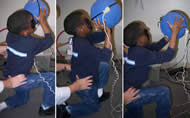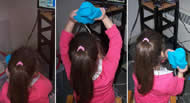Create an Adaptable Video Games Activity Program that Integrates Academic, Speech, Occupational and Physical Therapy IEP Goals Using HandsUp!
Rehabilitation Engineering Research Center – New Jersey Institute of Technology
Newark, NJ 07102
ABSTRACT
HandsUp! is an adaptable video game platform developed at New Jersey Institute of Technology that can be used to create and play custom made games for children with a diverse array of cognitive and physical abilities. An activity program was developed using personalized and adapted games made with HandsUp! that targeted goals related to academics, speech, physical and occupational therapy in the children’s Individual Educational Programs (IEPs). The children that are participating in this program have a wide range of ages, diagnoses, academic and therapeutic goals as well as interests and hobbies. This paper describes the methods we’ve used to create a custom video game experience for children to compliment their academic and therapeutic experiences at school.
KEYWORDS
video games, adaptability, assistive technology, recreation, IEP
BACKGROUND
Development of the HandsUp! platform has been inspired by the success of video games and virtual reality in the fields of research and rehabilitation (1). Platforms like Nintendo Wii have become commonplace tools to encourage people to be more active in their daily life. The Nintendo Wii requires the dexterity to hit at least one button on even the most simple games it offers. Nintendo Wii also offers limited control of the settings for the difficulty of the game to provide success to children who have very limited strength, range of motion, finger isolation and ability to grasp.
Other virtual reality platforms such as V-Tree, IREX, Playstation EyeToy, or games based on touch screen technology, all offer alternatives to traditional handheld video game controller interfaces. These platforms are controlled by various biomechanical movement patterns. Their common characteristics are that they provide a fun and recreational play environment, but they also lack full access to all game settings to personalize the level of difficulty settings for all levels of cognitive and physical abilities(2).
HandsUp! is well suited for children who struggle with the above mentioned video game systems. It has also proven to be an excellent augment to classroom activities such as matching, color identification, sequencing, etc. In the course of designing our activity program for First Children, Fanwood, NJ and Passaic County Elks Cerebral Palsy Center in Clifton, NJ we have gathered feedback from students, therapists, classroom teachers and computer skills teachers to create programs that offer something for everyone. Games have been developed that focus on letter recognition in order to spell their name, color, letter and number identification, matching and even sight words. Not only is the cognitive status of the child taken into consideration, but also the therapeutic goals. The parameters of the game can be easily modified to promote increased reaching range of motion, smoother movements, and depending on what type of colored marker is used, improvement in fine motor skills. Colored markers include but are not limited to mittens, socks over their hands, small balls, colored cylinders and even a pair of tongs in combination with a colored ball to promote a pincer grasp. Multiple positions are also used to incorporate motor skills such as standing balance, sit to stand and one footed stance.
METHOD
The goal of the HandsUp! activity program is to create a custom exercise program for a group of up to 15 children at each of two sites. The activity program should meet the needs of the education and therapy providers at the schools in line with their Individualized Educational Programs (IEP’s). The children selected could not play existing commercially available gaming systems. The activity program should also be enjoyable for the children and approved for safety considerations by the treating therapists and NJIT’s Internal Review Board who approves of any studies involving human subjects.
The HandsUp! activity program preparation began with an in service for all of the Occupational and Physical Therapists on site at the school. The goals of the project were explained to the staff and two open play days were scheduled at the participating elementary schools. On these days, the therapists could try the game with students they saw regularly and make recommendations of which of their students they would like to see participate in the HandsUp! activity program. Information was casually gathered about the children during the observation period about activities they liked, what they were learning in school and their favorite actors, TV shows, books, music etc.
Once the children were identified, letters were sent home to the parents and the families who were interested in participating then received consent forms to sign and return. A chart review was performed on each participant to achieve an overall perspective of the student’s school experience. Information about the child that was given priority:
- Medical information including, diagnosis, vision and hearing test results.
- Evaluation from Occupational Therapist including current goals.
- Evaluation from Physical Therapist including current goals.
- Evaluation from Speech Therapist including current goals.
- Academic evaluation including current goals.
Initial Game ideas were brainstormed and then reviewed with the treating therapists. Appropriate games were selected, then personalized for each child using HandsUp! Video Game Editor. The activity schedule was created by the classroom teachers to cause the least amount of disruption to their classroom time with consideration for the child’s therapy schedule. The children were assigned two thirty minute timeslots for each of 8 weeks. The therapists gave permission to overlap with their regularly scheduled timeslot if necessary because they believe the activity period can effectively be used while they work on their goals with the child.
Prior to starting the activity program, the treating occupational therapists administered The Beery VMI test to evaluate motor coordination, visual perception and visual-motor integration. This is a test that was already being used to evaluate children at the school and that the occupational therapists were trained in conducting. The same test is conducted on each child after completion of the eight week program. Over the course of the program, adaptions must me made to incorporate changes in the children’s goals, status, likes/dislikes and feedback from therapists.
An abbreviated case example would be:
Subject A, Spina Bifida, profound hearing loss, seizure free for 4 years.
OT Notes: Is easily distracted, goals include hand strengthening and grasp, upper body strength
PT Notes: Ambulates with crutches, left leg dominant, low tone in legs, absent tone in ankles. Goals include raising and lowering herself from a bench and picking up objects from floor.
Speech Notes: Is training to use Augmentative Communication device.
Educational Notes: Has difficulty staying on task and is stubborn. Learning parts of the body, matching uppercase to lowercase letters.
Game ideas were brainstormed including a matching game where a lowercase letter must be selected and dragged over to its uppercase partner. While in bench sitting, using a heavy red ball as a marker to play the game would help increase upper body strength and improve her graded control. After fatigued, a matching game with names and pictures of community workers like policeman and fireman could be played with a light blue magic wand to focus on improved fine motor skills and reaching. She might benefit from pairing with another child to practice taking turns and staying on task.
Subject A acquired new long leg braces during the time period of the program. These braces gave knee support and allowed inclusion of play in supportive standing to promote improved balance by challenging her dynamically to shift her weight and reach. The subject’s profound hearing loss did affect game selection for this subject. Games specifically designed to test skills related to following directions based on audio ques were not appropriate.
RESULTS
Custom games were successfully made for children with quite varied physical and cognitive profiles.
Physically, one end of the spectrum included an overactive, uncoordinated young boy with autism spectrum disorder and the other end of the spectrum included a wheelchair bound girl with Spinal Muscular Atrophy (SMA), limited range of motion at the elbow and shoulder and no antigravity movement in her upper extremities. We could incorporate the therapeutic goals of the autistic young boy into game play by having him play a Spiderman themed game in a half kneel with a weighted ball. He not only enjoyed the challenge of the game, but the therapists were amazed with how well he attended to the activity. For the young girl with SMA, we offered an opportunity to play a High School Musical themed game on her own accord, by mounting the camera above her tray and asking her to slide light objects across her tray. Due to the progression of her disease and the limited mobility she now has, she cannot play other types of video games. The smile on her face when she was able to play the game on her own was priceless. Students were able to play the game in a variety of poses.
Some children that participated had very limited academic goals. For these children, a very simple puzzle game was created that included no moving parts, just four small pictures that quadrupled in size when touched to unveil a large picture of something the child enjoyed. For this child, the primary goals were attending to task, reaching and demonstrating cause and effect. Other children had nearly age appropriate academic goals. Games made for them included selecting letters in proper sequence to spell their name, matching site words with the corresponding picture, and selecting numbers to correctly count in sequence or practice recalling their phone number. Children of all ages and cognitive status love to play video games. The children’s response to the games and the positive feedback from therapists and teachers was excellent.
DISCUSSION
Development of the activity program demonstrates that custom video games can be created for children over a wide spectrum of physical and cognitive abilities while considering not only their medical diagnosis but also their therapeutic and educational goals. Adding two more thirty minute slots into the busy weekly schedule of these children could have been met with opposition from their teachers, therapists, parents and other school administration, but we received a tremendous amount of support for our development project. Demonstrating an understanding of the mission of each part of the students’ school experience and doing our best to include it in the game design contributed in our success in our collaborative efforts.
REFERENCES
- Miller, F. & Bachrach, S., Cerebral Palsy: A Complete Guide for Caregiving.
- Baltimore, MD: Johns Hopkins Univ Press, 1998.
- Chen, Yu-Ping et al. Use of Virtual Reality to Improve Upper-Extremity Control in Children with Cerebral Palsy: A Single-Subject Design. Physical Therapy, Nov2007, Vol. 87 Issue 11, p1441-1457, 17p; (AN 27435670)
ACKNOWLEDGMENTS
The staff at First Children, Fanwood, NJ and Passaic County Elks Cerebral Palsy Center in Clifton, NJ has been invaluable contributors in this project. Special thanks to Mary Frese, OTR and Laura Haug, CCC-SLP who acted as site coordinators. The establishment of the Hands-Up! User Community is supported by a grant from the NEC Foundation. The development of Hands-Up! is supported by Grant #H133E050011 from the National Institute on Disability and Rehabilitation Research of the U.S. Department of Education. The Toys R Us Foundation offered support in funding of the equipment at the Passaic County Elks Site.
Author Contact Information:
Amanda Irving, MS, New Jersey Institute of Technology, 232 Martin Luther King Blvd., Newark, NJ 03073, Office Phone (973) 596-3043 EMAIL: aai2@njit.edu
Sheila Blochlinger, PT, Children’s Specialized Hospital, 150 New Providence Road, Mountainside, NJ 07092-2590, Office Phone (908)301-5446. EMAIL: sblochlinger@childrens-specialized.org
Word Version PDF Version
